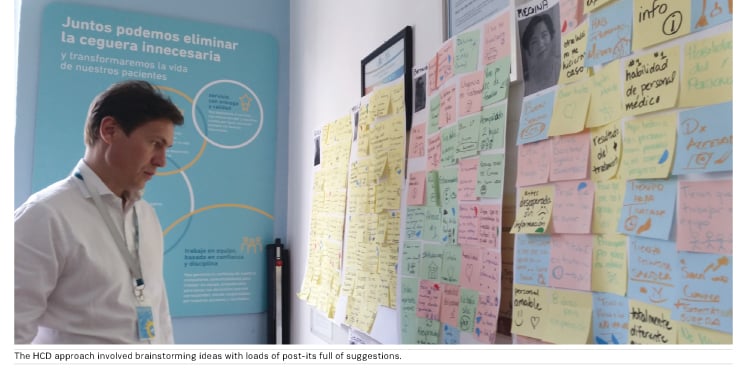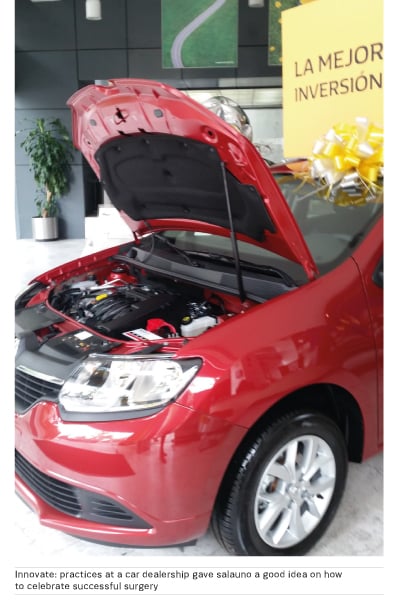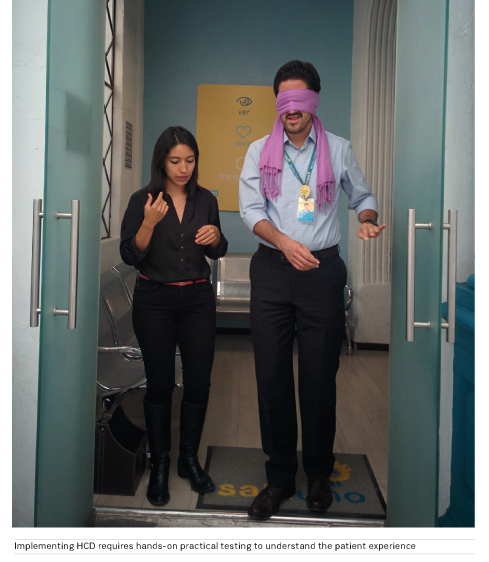HealthManagement, Volume 17 - Issue 5, 2017
How salauno has used an interdisciplinary team with a Human-Centred Design approach with impressive patient results.
Salauno was founded in 2011 to eliminate needless blindness in Mexico where it is the second biggest cause of disability. Salauno’s model is low-cost, high-quality and high-volume which has allowed it to attend to 200,000 low-income patients and carry out 29,000 surgeries that have restored eyesight.
In 2016, salauno decided to focus on improving the patient experience. We had been measuring patient satisfaction with the Net Promoter Score for over a year so we had solid data and knew we were doing well but wanted to take the patient experience to the next level. We knew we wanted to create a ‘wow factor’ for each patient, but had never defined what that meant. We turned to Human-Centred Design (HCD), a creative approach to problem solving, to take on this project. I would like to share some of our lessons learned.
We found that the key to successfully redesigning the patient experience is to adopt an HCD mindset which means:
Accept that you do not know
Although many of us have been working with our patients for years and feel like we know them inside and out, it is key to embrace the idea that because we have never asked these questions or been open to hearing everything they think and feel, we are going to learn from our patients. Develop empathy Since we will be hearing new perspectives, it is likely that we will discover surprising points of view with which we do not necessarily agree. We do not need to agree with our patients; we just need to understand them, in order to then design for and with them. At salauno this meant that when patients told us they found the plain old plastic chairs much more comfortable than our pretty shiny metallic chairs, we had to remember that we were designing for them, not us.
Question everything
If we want to truly innovate in the patient experience, we must question the status quo. Just because things are done a certain way doesn’t mean they should continue to be done that way. In fact, when you ask why something is done a certain way and the response is that it’s always been done this way, you’ve probably found something ripe for change.
Try new things
If we want to truly redesign the patient experience, we must be willing to try new things. If not, it’s a waste to go through this entire process and would be more productive to go with the first idea that comes up in a meeting. The HCD process will lead us to what may seem like improbable or crazy ideas and we must be willing to test and try things before simply discarding them.
Learn from failure
If we follow the HCD methodology properly, we are guaranteed to fail...at some of our ideas. This is normal and as long as we make sure to learn from those failures, they will be a productive part of the process. At salauno this meant that our brilliant idea of using QR codes to educate patients didn’t work because very few people knew how to scan a QR code and even fewer had a QR reader on their phone.
Iterate, iterate, iterate
I guarantee that no idea will survive unchanged. Ideas will fail or morph along the way. We must adapt and move quickly to get to the right iteration of an idea. At salauno this meant that we started out with an informative multi-page booklet that patients barely looked at after receiving it upon their arrival. The booklet turned into one single sheet distributed per consultation step that patients spent two more seconds looking at before folding and putting away. The single page info sheets finally morphed into laminated sheets handed out at each step that patients actually did read. We would never have guessed that laminating would be the key to making this idea work.
Interdisciplinary team
With this mindset established, you need to assemble an interdisciplinary team. You can’t get the kind of innovation you need if you gather the usual suspects (top management) to define solutions. At salauno, this meant putting together a team that included a doctor, optometrist, clinic assistant, clinic managers and quality and process staff.

With the team in place, you can structure your project according to the 3 main phases of HCD:
- Listen: In this phase we listen to the
patient’s voice. This involves conducting ethnographic interviews (open ended
questions to understand patients feelings and experiences without guiding them
to the “right” answer), analysing existing data/patient input, and conducting
immersions. While some feel there is no need for this phase (“I already know my
patients”) and some feel they could spend months on this phase (“we haven’t
spoken to every patient type yet”), the methodology encourages us to assume
that we don’t know and yet also not attempt to do a statistically significant
study. At salauno, in addition to interviewing patients, we went to analogous
contexts like hotel lobbies and children’s hospitals and did shadowing and
empathy exercises to better understand our patients’ experiences. We closed
this phase with a step-by-step map of the patient experience with problem areas
identified.
- Create: In this phase we create solutions
to the problems we identified. This involves many brainstorming sessions (full
of post-its!). The keys to success are to focus on quantity, not quality of
ideas (at first), to not pre-filter ideas and to allow for the most audacious
ideas to come out first (if you don’t allow them to come out in this phase,
they never will) and to look for inspiration in unexpected places (if we only
look to other healthcare providers, we will only make incremental improvements,
but if we look elsewhere we can start to truly innovate). At salauno, we were
inspired by how car dealerships celebrate closed sales and created the idea of
ringing a bell whenever we had a recovered patient released post surgery so
that staff could gather to applaud and congratulate the patient (thus also
fostering confidence in other patients). We closed the phase with a list of top
ideas that we wanted to test.
- Test: In this phase we test the ideas we
have developed. The key to success in this phase is to get physical. In order
to truly test an idea, we cannot just talk to patients about it - we must put
it in front of them. This is where prototypes come in. We can prototype with
mockups, drawings, legos, simulations or anything else that enables patients to
really experience our idea. This is key to getting real and honest feedback so
we can iterate as needed until the idea passes the patient test. It’s much
better for an idea to fail or require changes while being developed as opposed
to once it’s fully launched across your health system. At salauno, we had the
idea of having physicians fill out a personalised take-home visit summary for
patients. During testing, the sheet was consistently left blank so we realised
that, though it was a good idea, it was too manual and time consuming for our
current operation. We closed the phase with a final list of concepts validated
by tests (and some that died in the process).


Implementation
Once this HCD process is completed (which at salauno took two months), we must focus on implementation and standardisation so that the ideas we designed really make it all the way to the patient in a consistent way. This involves creating staff awareness, training, manuals, audits and other mechanisms in daily operations to make the leap from theory to practice.
To apply HCD in your setting, I recommend the IDEO Design Kit (designkit.org/resources/1), a useful free online HCD resource. Of course, I’m also happy to connect to discuss your particular project.
Key Points
- Human-Centred Design (HCD) is a creative
approach to problem solving
- Assemble an interdisciplinary team rather
than follow the status quo style of project implementation and management
- Accept that you don't know as much as you
think
- You do not need to agree with patients; you
just need to understand them
- Just because something has always been done
a certain way doesn't mean it should remain that way
- Accept some ideas will fail and learn from
this
- Be creative and allow for expression of
what may seem to be outlandish ideas – they may be the best ones
- Test ideas with patients in a practical
manner for authentic results
- HCD embraces an iterative process in the
development of a new practice
















